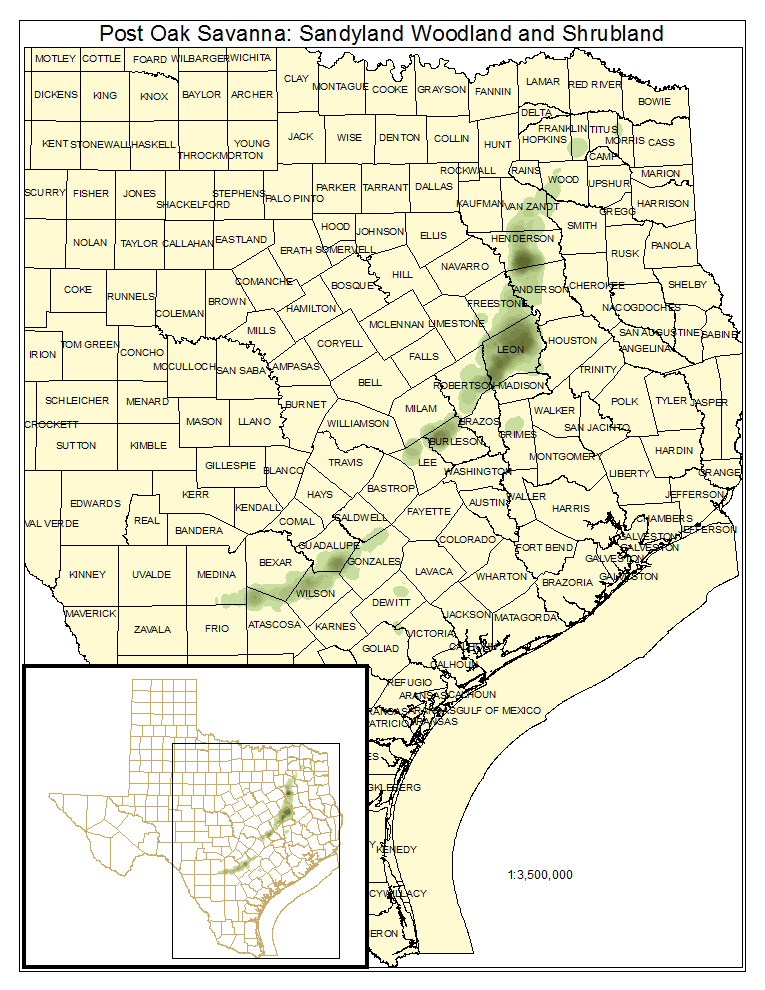East-Central Texas Plains Xeric Sandyland
Geology
Associated with Eocene sand formations, particularly Carrizo Sands, but also Queen City and Sparta Sands.
Landform
High topographic positions, along with rapidly draining soils, results in conditions that only briefly retain surface moisture.
Soils
Deep sands typify this system.
Parent Description
This small patch system is typically an open, herbaceous-dominated sand "prairie," sometimes with open, oak-dominated woodlands. Species such as Quercus incana (bluejack oak), Quercus margarettae (sand post oak), Quercus stellata (post oak), and Carya texana (black hickory) (often stunted) occur in the usually sparse overstory. Invasion by Ilex vomitoria (yaupon) is frequent in the absence of fire. Other woody plants that may be encountered include Juniperus virginiana (eastern redcedar), Rhus aromatica (fragrant sumac), Vaccinium arboreum (farkleberry), Viburnum rufidulum (rusty blackhaw), Rhus copallinum (flameleaf sumac), and Cornus florida (flowering dogwood). The herbaceous layer may be sparse, often with exposed sand, Cladonia spp. (foliose lichens), and species such as Aristida desmantha (curly threeawn), Brazoria truncata (bluntsepal brazoria), Cnidoscolus texanus (Texas bull-nettle), Dichanthelium spp. (rosette grass), Sporobolus junceus (pineywoods dropseed), Froelichia floridana (Florida snake-cotton), Hymenopappus artemisiifolius (old plainsman), Lechea spp. (pinweed), Loeflingia squarrosa (spreading loeflingia), Opuntia humifusa (eastern pricklypear), Paronychia drummondii (Drummond nailwort), Polanisia erosa (large clammyweed), Schizachyrium scoparium (little bluestem), Monarda punctata (spotted beebalm), Senecio ampullaceus (Texas groundsel), Sorghastrum elliottii (slender Indiangrass), Stylisma pickeringii (bigpod bonamia), Tetragonotheca spp. (nerve-ray), Gaillardia amblyodon (maroon gaillardia), Rhynchosia americana (American snoutbean)S, Zornia bracteata (bracted zornia), and Triplasis purpurea (purple sandgrass). Species such as Cyperus grayoides (Illinois flatsedge), Penstemon murrayanus (cupleaf penstemon), Selaginella arenicola ssp. riddellii (sand spikemoss), Tradescantia reverchonii (Reverchon spiderwort), and Yucca louisianensis (Gulf Coast yucca) may be present, but primarily to the east, while Tephrosia lindheimeri (Lindheimer goat-rue) and Rhynchosia americana (American snoutbean) are frequently encountered to the south. Texas endemics, such as Brazoria truncata var. pulcherrima (Centerville brazos-mint), Rhododon ciliatus (Texas sandmint), and Hymenopappus carrizoanus (Carrizo Sands woollywhite), may be found in this system.
Ecological Mapping Systems
Post Oak Savanna: Sandylands Woodland And Shrubland
As described for the system, but overstory dominated by the woody species described. This may be a common condition, especially where fire is excluded.
Distribution Map

Photos

Post Oak Savanna: Sandyland Grassland
As described for the system, but lacking significant woody component. This vegetation type is representative of the system in good condition, with a fire cycle more consistent with the presumed natural cycle.
Distribution Map

Photos

Public Land Occurrence
- None.